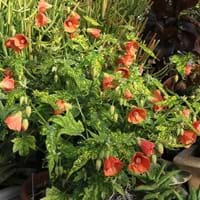Life Span
Perennial
Perennial
Origin
Hybrid origin
World/Pandemic
Types
Aristocrat, Buckeye Belle, Henry Bockstoce , Abalone Pearl, Coral Supreme, Cytherea, Charlie's White
Abutilion pictum "Mardi Gras"
Abutilon pictum "Thompsonii"
Habitat
Hillside, Woods
gardens, Marshy ground, meadows, Suburban areas
USDA Hardiness Zone
Not Available
8-10
Sunset Zone
Not Available
H1, H2, 8, 9, 12, 13, 14, 15, 16, 17, 18, 19, 20, 21, 22, 23, 24
Habit
Clump-Forming
Clump-Forming
Flower Color
Not Available
White, Yellow, Red, Orange, Pink, Peach, Dark Red, Copper, Bronze
Flower Color Modifier
Bicolor
Not Available
Fruit Color
Not Available
Brown
Leaf Color in Spring
Not Available
Green, Gray Green, Dark Green
Leaf Color in Summer
Not Available
Green, Gray Green, Dark Green
Leaf Color in Fall
Not Available
Green, Gray Green, Dark Green
Leaf Color in Winter
Light Green
Green, Gray Green, Dark Green
Leaf Shape
Compound
Maple shaped
Plant Season
Spring, Summer
Spring, Summer, Fall, Winter
Sunlight
Full Sun, Partial Sun, Partial shade
Full Sun, Partial Sun
Type of Soil
Clay, Loam
Loam, Sand
The pH of Soil
Acidic, Neutral, Alkaline
Acidic, Neutral, Alkaline
Soil Drainage
Average
Average
Bloom Time
Not Available
Indeterminate
Tolerances
Drought
Not Available
Where to Plant?
Ground, Pot
Ground, Pot
How to Plant?
Grafting, Seedlings, Stem Planting, Transplanting
Seedlings, Stem Planting
Plant Maintenance
Medium
Medium
Watering Requirements
Does not require lot of watering, It cannot sustain wet-feet, Keep the ground moist but not water-logged, Needs watering once a week, Prefer drip-irrigation instead of Over-head watering, Water occasionally
Average Water Needs
In Summer
Lots of watering
Lots of watering
In Spring
Moderate
Moderate
In Winter
Average Water
Average Water
Soil pH
Acidic, Neutral, Alkaline
Acidic, Neutral, Alkaline
Soil Type
Clay, Loam
Loam, Sand
Soil Drainage Capacity
Average
Average
Sun Exposure
Full Sun, Partial Sun, Partial shade
Full Sun, Partial Sun
Pruning
Do not prune during shooting season, Prune to control growth, Remove dead or diseased plant parts, Remove deadheads
Shape and thin as needed
Fertilizers
All-Purpose Liquid Fertilizer
All-Purpose Liquid Fertilizer
Pests and Diseases
Botrytis Blight, Leaf spot, Stem spot, Viruses
Insects
Plant Tolerance
Drought
Drought
Flower Petal Number
Not Available
Single
Foliage Texture
Not Available
Medium
Foliage Sheen
Not Available
Matte
Attracts
Ants
Birds, Hummingbirds
Allergy
Not Available
no allergic reactions
Aesthetic Uses
Beautification, Bouquets, Showy Purposes, Used for decorating walls, fences, gates, hedges, etc.
Showy Purposes
Beauty Benefits
Not Available
Not Available
Environmental Uses
Air purification
Air purification
Medicinal Uses
Cough, Gout, Headache, Heartburn, Kidney problems, Upset stomach, Urinary tract problems
No Medicinal Use
Part of Plant Used
Flowers, Root, Seeds
Flowers
Other Uses
Showy Purposes, Used as Ornamental plant, Used for fragrance
Culinary use
Used As Indoor Plant
No
No
Used As Outdoor Plant
Yes
Yes
Garden Design
Cutflower, Feature Plant, Foundation, Mixed Border
Bedding Plant, Container, Feature Plant, Foundation, Hedges, Mixed Border, Topiary, Bonsai, Espalier, Tropical
Botanical Name
PAEONIA 'Rachel'
ABUTILON pictum
Common Name
Intersectional Peony
Redvein Abutilon
Chinese-lantern
Red Vein Indian Mallow
In Hindi
Intersectional Peony
भारतीय मैलो
In German
Intersectional Pfingstrose
indische Malve
In French
intersectionnelle Pivoine
Mallow indienne
In Spanish
interseccional Peony
malva india
In Greek
διατομεακές Παιώνια
Ινδικό Μολόχα
In Portuguese
interseccional Peony
Mallow indiana
In Polish
międzysegmentowe Piwonia
Indyjski Mallow
In Latin
Intersectional AGLAOPHOTIS
vitifolium
Phylum
Tracheophyta
Not Available
Class
Magnoliopsida
Magnoliopsida
Order
Saxifragales
Malvales
Family
Paeoniaceae
Malvaceae
Clade
Angiosperms, Core eudicots, Eudicots
Angiosperms, Eudicots, Rosids
Tribe
Not Available
Malveae
Subfamily
Not Available
Malvoideae
Season and Care of Intersectional Peony and Indian Mallow
Season and care of Intersectional Peony and Indian Mallow is important to know. While considering everything about Intersectional Peony and Indian Mallow Care, growing season is an essential factor. Intersectional Peony season is Spring and Summer and Indian Mallow season is Spring and Summer. The type of soil for Intersectional Peony is Clay, Loam and for Indian Mallow is Loam, Sand while the PH of soil for Intersectional Peony is Acidic, Neutral, Alkaline and for Indian Mallow is Acidic, Neutral, Alkaline.
Intersectional Peony and Indian Mallow Physical Information
Intersectional Peony and Indian Mallow physical information is very important for comparison. Intersectional Peony height is 71.10 cm and width 60.00 cm whereas Indian Mallow height is 30.00 cm and width 180.00 cm. The color specification of Intersectional Peony and Indian Mallow are as follows:
Intersectional Peony flower color: Not Available
Intersectional Peony leaf color: Not Available
Indian Mallow flower color: White, Yellow, Red, Orange, Pink, Peach, Dark Red, Copper and Bronze
- Indian Mallow leaf color: Green, Gray Green and Dark Green
Care of Intersectional Peony and Indian Mallow
Care of Intersectional Peony and Indian Mallow include pruning, fertilizers, watering etc. Intersectional Peony pruning is done Do not prune during shooting season, Prune to control growth, Remove dead or diseased plant parts and Remove deadheads and Indian Mallow pruning is done Shape and thin as needed. In summer Intersectional Peony needs Lots of watering and in winter, it needs Average Water. Whereas, in summer Indian Mallow needs Lots of watering and in winter, it needs Average Water.





